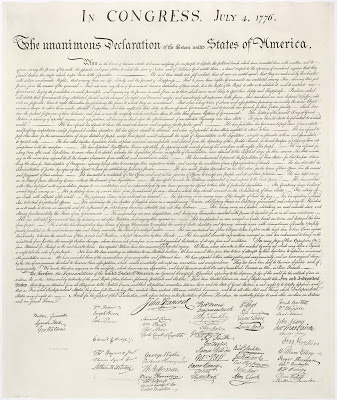From The Adventure Gamer
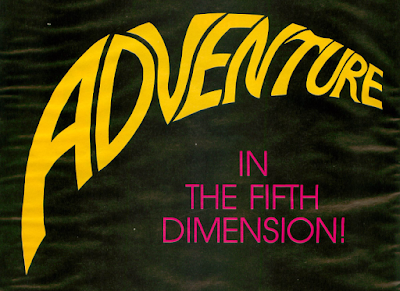 |
| A funny thing happened on the way to Wishbringer… |
As we start into 1985 in our Infocom marathon, we need to bring one new and influential game designer into focus: Brian Moriarty. Mr. Moriarty is the designer behind Wishbringer, as well as Trinity (which I know nothing about) and Beyond Zork. After leaving Infocom, he was the designer on Loom for LucasArts, one of my all-time favorite titles, plus smaller roles in other games. The more I dug into his history, the less I wanted to cram it all into one post. So instead, we’re going to take a brief detour into Adventure in the 5th Dimension, Mr. Moriarty’s very first text adventure game.
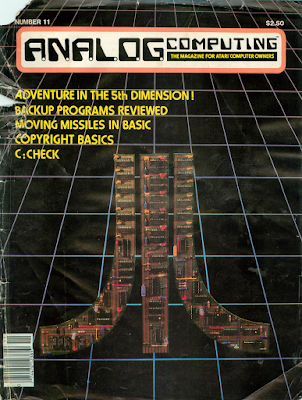 |
| Back when Atari was cool. |
Unlike so many of the Implementors that we’ve looked at before, Moriarty didn’t come out of MIT. Instead, he was a literature major at Southeastern Massachusetts University, now known as UMass Dartmouth. He didn’t immediately jump into software development, rather he started at Radio Shack. At least according to his excellent biography compiled by the Digital Antiquarian, he didn’t even play adventure games before 1981. Moriarty leveraged his newfound computing passion with his liberal arts background and was able to land a job as a Technical Writer for Bose, all the while getting deeper into the Atari systems that he had been introduced to at his previous job. Somewhere around this time, at least as Mr. Antiquarian tells it, Moriarty set for himself the goal of working as a game designer at Infocom. To do that, he’d need to strengthen his resume for the skills and experience that his prospective future employer would need.
At this time, ANALOG Computing was the premier “unofficial” magazine of Atari computers. Thanks to some connections through his experience at Radio Shack, he was able to begin some freelance work for the publication starting in Issue #7 from July 1982. Six months (and three issues) later, he joined the magazine officially in their “Technical Division”. By Issue #14, September 1983, he had been promoted to “Technical Editor”. He remained there for nearly another year; his last issue as Technical Editor was September 1984. The skills that he picked up at ANALOG were the start of what he would need for that hoped-for job, but they weren’t quite enough. While Infocom passed him over for a job as a designer, they did hire him as a deep-coder to help port their engines onto new platforms and keep pace with the features of the growing Z-machine. He had his foot in the door, but for our story we’re getting a bit ahead of ourselves.
In his time at ANALOG, Moriarty wrote more than two dozen reviews and editorials. If you are willing to do some searching, you can find them all online at the Internet Archive. Reading through it all, I am struck by someone that had both a deep technical aptitude as well as an ability to write well. Most of his reviews are extremely technical, reviewing graphics boards and new disk drives. He reviewed BASIC and PASCAL compilers, and even an Atari implementation of LOGO, a children’s learning language. (In fact, part of the impetus for writing 5th Dimension may have been to have fodder for his BASIC compiler review.) He only wrote two reviews of games, but I will come back to those in a moment. Those are augmented by some fantastic and very deep utilities that he wrote for the platform: The Black Rabbit, a disk duplicator that could copy disks in one pass; SNAIL, software to correct a disk timing bug on older Atari systems; and mUse, software to analyze and optimize memory utilization in Atari BASIC programs. Black Rabbit also had a 2.0 version released as part of an ANALOG compilation book. He could write, he could review, and he could engineer software that demonstrated an in depth understanding of the Atari. No wonder he was a good fit for Infocom!
In his time working for the magazine, he wrote exactly two game reviews and they tell us a lot about the way he viewed adventure games: one on Suspended for Issue #12 and one on Sierra’s Dark Crystal for Issue #13.
His Suspended review reads more like a love letter to his future employer than a critical review:
What is Infocom’s secret? Why does a 4-year-old text game like Zork continue to flourish when even the venerable Scott Adams Adventure Series (now “enhanced” with flickering graphics) fails to hold the interest of computer enthusiasts?
The answer, I think, has less to do with Infocom’s famous packaging than with the fundamental quality of their products. When I play an Interlogic adventure, I don’t get the feeling that the thing was coded according to a formula, shrink-wrapped and shoved out the door in a couple of weeks. There’s a sense of completeness and pride in engineering, as if the programmer had a genuine emotional investment in the game. Suspended, the latest offering in the Interlogic Science Fiction Series, conveys this sense of personal authorship more than any other computer adventure I have played.
That is high praise, although I can’t help but think he meant it more for Infocom’s prior games rather than Suspended in particular. Now compare this to the very lukewarm reception that he gave to Dark Crystal:
 |
| It really did have attractive packaging… |
I spent the better part of an evening mapping out Dark Crystal. I wandered through almost forty different locations and exhausted three of the five picture-disk sides. Aside from a few unavoidable encounters with characters telling you what to look for, nothing happened. There were no threatening situations, no puzzles, mazes or unusual objects to pick up, just cute little creatures peeking out from behind trees, and a couple of dead ends. The handsomely printed owner’s guide tells you most of what you need to know about your mission; very little is left to the imagination.
Dark Crystal seems to be more concerned with re-creating the events and scenery of the movie than with providing a fun game. Despite its fine packaging and professional engineering, I still prefer On-Line’s previous Hi-Res Adventures for the ATARI.
We haven’t played Dark Crystal yet (it’s on my list after Infocom, although when that will be is anyone’s guess), but I can’t help but feel that the whole review is a condemnation of the emptiness of graphical adventures over the deep exploration of the textual type. As an early statement on his likes and dislikes as an adventure player, it’s interesting to consider both of these reviews in the context of Moriarty’s subsequent career as an adventure writer.
And that brings us to Adventure in the 5th Dimension, the first of two games that Brian Moriarty wrote during his time at ANALOG. Published in Issue #11, March 1983, it is a short mostly-BASIC type-in adventure. We’ve looked briefly at type-in software here in the past (most notably Crisis at Christmas from 1986), but the idea was that the software had to be manually keyed in by the gaming enthusiast prior to playing. With some games being hundreds of lines of code, all having to be entered in perfectly, that was a pretty high bar for the player. But as a way to distribute small games and other software for “free”, type-ins were extremely economical. In this case in specific, Moriarty produced a type-in that could work even on the low-end Atari systems, running in only 16k of RAM. I’d love to tell you how small 16k of RAM is, but it seems inconceivable today. Even more impressively, he coded his game largely in BASIC to make it understandable for magazine readers to learn from. This is in contrast to Crisis which was essentially manually-entered assembly language, long strings of unintelligible “DATA” lines, just numbers followed by numbers followed by numbers. He even included more than a page of technical design notes in the magazine to describe his key data structures so that aspiring programmers could learn from his example. I’ve read through some of the Atari BASIC and found it extremely well written, or at least as well-written as BASIC software can be. He does warn the reader that they have to copy the source exactly, including the “REM” (comment) statements; I can only imagine what sort of non-portable optimization tricks he is getting into to make that a requirement…
One of the great bonuses from the Internet Archive copies of ANALOG #11 is that they scanned theirs from a “well loved” copy. Whomever owned this issue in the past not only played this game, they also scrawled little margin notes to help them better understand the code that Moriarty had written. This is a beautiful time capsule and I’m glad that someone got some joy out of understanding how this game works.
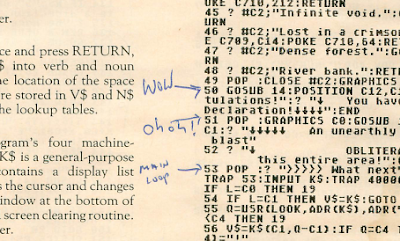 |
| Oh oh! This is awesome! |
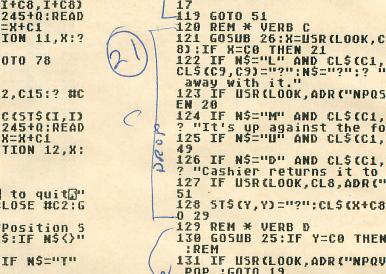 |
| They blocked out the code like this to understand his use of subroutines. |
The plot of the game, as described in the magazine, is brilliant in its own way: a group of aliens have descended on Washington, D.C. and stolen the United States Declaration of Independence. We are investigators, hired to recover the priceless object. Exactly how we’re supposed to chase down a document stolen by aliens is unclear, but the manual warns us that we will need to find a way into their alien dimension to recover it. It also warns us that even exploring the confusing streets of Washington may be difficult…
With that, I think there is nothing left but to play the game!
Playing the Game
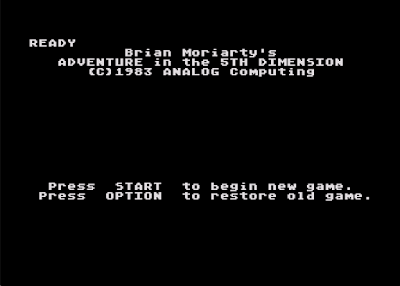 |
| Awfully cheeky to put your name in the title of your first game… |
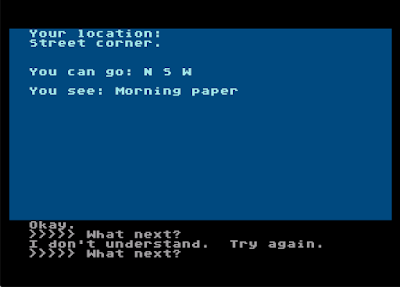 |
| Let’s just say that the room descriptions are “brief”. |
We start the game and find ourselves on a street corner in Washington, D.C. Or at least, that’s what the manual says because the game is exceptionally terse. I suppose that is what we have to expect for a game that runs in 16K of RAM! There’s a newspaper here which says very simply that the “Declaration is stolen.” The Declaration of what? Good thing I read the manual!
Leaving here, I quickly realize that this game commits one of my most hated sins of adventure games: starting in a maze. I ripped Wizard and the Princess for this design choice and I’m even less happy about it here. We start in a maze with literally one object that we can use for our mapping, the morning paper. I wander randomly and discover a “stone” which I can use to map other rooms but there still isn’t enough to go on. I honestly just give up mapping and explore randomly. I discover a store that sells batteries, but I have no money. I also find a dead end alley that has a fire escape that I can climb. I clamber up past a locked window and onto the roof where there is an “alien spheroid” that I can pick up. With one more object to map with, that lets me find a well-hidden police station. That’s where the manual says that I have to return the Declaration of Independence! In the bathroom of the police station is an alien symbol that looks like “^^^” and a dollar; I pocket the cash.
That finally gives me enough objects that I can map the whole area, but there are no more key rooms to find than the ones I discovered randomly. I use the dollar bill to buy the “green battery” at the store. The alien spheroid has an attachment for a battery and I think that must be it, but it turns out that the green battery doesn’t fit. (I am also instructed that I must refer to it by color, so presumably there are other colored batteries around someplace.) None of the other objects seem useful and the only puzzle that remains that I know of is the locked window. Should I just break it? I do! I take the stone up to the window and break it open. That opens into someone’s bedroom with a broken radio. I hope I wasn’t the one to break it… Examining the radio, I find a blue battery inside. That battery thankfully plugs into the alien device (why?) and disappears. Now where do I go? I explore the whole place again and this time when I am in the bathroom of the police station, the graffiti has been replaced with a transdimensional portal. I can follow the aliens! At this point, I should mention that I have a maximum inventory size of four and we have found more than four objects. This will be important in a moment.
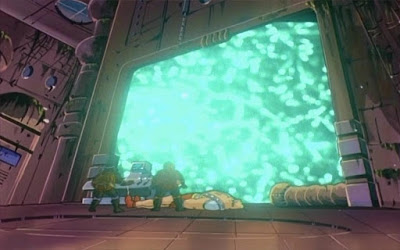 |
| Like this but in 16k. |
On the other side of the portal is a collection of multi-colored “voids”. I start out in a white void and in the nearby rooms, I also find voids that are “golden”, “green”, “crimson”, and “infinite”. The golden void contains a shimmering mass which explodes (killing me) if I try to touch it. The crimson void, which appears to be purple in my emulator, is a mini-maze but thankfully I have brought along enough items to map it, revealing a pair of shimmering gloves. The green void contains one of the 5th dimensional beasts and an alien cube, but the beast doesn’t let me pick up the cube although it seems harmless otherwise. Most importantly, the “infinite” void contains the Declaration of Independence on the far side of a force field.
Experimenting a bit, I discover that when I wear the shimmering gloves, I can pick up the mass! I can carry it around, but still need to be careful because it can easily blow up if I take off the gloves or do anything funny around it. If I drop the strange mass in the room with the forcefield, I get a slightly different message that says that it is pushed up against the field. I’m going to take that as a clue that I am on the right path.
At this point, I realize that in my haste I completely didn’t notice all of the exits in the white void: there is no path back “down” to the police station, but there is an “up” through another portal into what appears to be a wilderness. One room over and I find a riverbank with a British soldier and a bayonet. He doesn’t attack me, but he won’t let me take the bayonet. When I examine it, it tells me that the “stock” is dated 1775. At this point, I have to wonder both why the British soldier is letting me get close enough to it to read a date inscription on his gun, but also whether Mr. Moriarty knows what a “bayonet” is. The bayonet is the blade placed at the end of a musket, not the musket itself.
 |
| Revolutionary war musket with bayonet. |
That confusion aside, this game has time travel! How awesome is that! We have to rescue the Declaration of Independence by traveling back to the Revolutionary War! Unfortunately my excitement is short lived because the whole “time travel” area consists of two rooms and there is nothing else to do. In fact, I am stuck.
I re-read the manual and it gives me one bit of advice that I missed: I can get help by pressing the “H” key. I do that in each room and there are (mostly) different contextual help messages. In the maze of the crimson void, for example, it tells me that I need to create a map. In the white and infinite voids, it asks me how my “pitching arm” is lately. In the room with the soldier, it helpfully tells me that he is thirsty. Since I haven’t found anything to drink, I’m going to trigger on the “pitching arm” comment to think that I might need to throw the stone that I picked up in the previous section. Unfortunately, I left it in that Washington since I could only bring across four items. I admit that I didn’t pick the best four items since I took the battery, paper, radio, and spheroid, but I certainly would not have thought the stone would have had a second use after breaking the window. I also didn’t quite realize it was a one-way trip at first.
 |
| My completed map of the game. |
I restart the game from scratch and progress quickly. This time, I take the stone with me, as well as the battery and spheroid. In the process, I also realize that I missed a room! There’s another exit other than the bedroom in the house that I broke into: the kitchen. That contains a tea bag which I pocket and use as the fourth item that I will take into the “5th dimension”. I also verify that I can “throw stone”: not only does the game recognize the command, it asks me a cardinal direction to throw it in. Score! From here, it’s just a matter of connecting the dots. When I give the British soldier the tea bag, he leaves and doesn’t take the “bayonet”. I pick that up. If I set up the mass next to the force field (using the gloves), I step back into the white void and throw the stone off to the west. That causes an explosion and I have the Declaration of Independence! Good thing the blast didn’t damage the priceless artifact, eh?
Now here we hit another little “error” in the game. If you read the Declaration, it starts with “We the People”. Maybe Mr. Moriarty did not remember his fourth grade history classes, but here is a refresher:
 |
| This is the United States Constitution. |
I have to say that I am a bit disappointed that Brian Moriarty, skilled coder extraordinaire, doesn’t seem to know either what a “bayonet” is, nor which foundational document of the United States starts with the phrase “We the People”. I’m not going to deduct points for getting it wrong, but it’s a bit surprising that he managed to slip up like that.
From here, I have the game pretty much solved but there is no way home. The only remaining obvious puzzle is the 5th dimensional aliens themselves. It takes me some time, but I work out that I can “kill” them with the bayonet (sadly, “scare”, “threaten”, “hit” or other less direct actions were unrecognized) and that scares them off. That allows me to grab the alien cube and, just like the sphere, it has a battery slot. I use the green battery from the beginning of the game and that opens the transdimensional portal back to the present day Washington, D.C. I drop the Declaration of Independence… er… Constitution…. er… whatever off with the Sergeant at the police station and I win!
The ending screen is a bit lame, but what can you expect for a game that fits in 16k?
Time Played: 2 hr 05 min
Final Rating
Before I rate this game, I want to say that doing so is just shy of unfair. This is a game that was designed in part as an educational tool, in part as a way to test BASIC compilers, and entirely as a way for Mr. Moriarty to prove that it was possible to still have games on the oldest and least powerful 16k Atari systems. Being a type-in also limits the size of the game that could be offered. A low score here means only that the game compares poorly to 1990s graphical adventures, not that it doesn’t have its own charms.
That said, this is a game where you have to chase aliens through time and space to recover the United States Declaration of Independence! How cool of an idea is that? I’d totally buy an updated version of that premise.
Let’s see what we get:
Puzzles and Solvability – The game starts off with my pet peeve: an opening maze with minimal items to map with. Moriarty at least manages to size it correctly so that it was difficult but not impossible to navigate it randomly and that you could find other objects inside that would assist in mapping the rest. I suppose in that respect it is a well-designed opening maze, but I question what it adds to the game except a slightly greater challenge in the beginning. I also disliked the walking dead situation where you could only bring a few items across into the aliens’ area and it seemed as if we already had used the stone. I really liked the throwing puzzle and the help system. In a game this small, context-sensitive help system that nudges you in the right direction without giving you the answer outright is a huge bonus. My score: 2.
Interface and Inventory – When the manual touts that the interface has a “blinking cursor”, you know you are in for a treat. The interface was passable even if not completely consistent, a standard two-word job from the days of Colossal Cave. I struggled a bit with synonyms, especially at the end where it took me too many tries to figure out that I needed to “kill” the aliens. My score: 1.
Story and Setting – The story in the manual is fantastic but very little of that makes it into the game itself. To make it worse, I do not get at all why our character needs to see Washington, D.C. as a maze. He probably lives there! And to also get the Declaration of Independence wrong? That’s barely forgivable considering that is the whole macguffin of the game. I did enjoy the time travel surprise and the void area was suitably alien. My score: 2.
 |
| Not crimson, but at least a different color. |
Sound and Graphics – As usual, there are no graphics here but I considered some bonus points for the colored backgrounds in the aliens’ realm. I don’t think that is quite enough to bump the score up to “1”, but it was a nice touch at least. My score: 0.
Environment and Atmosphere – The premise of this game is fantastic, but the text is so minimal that it never develops a character or a feeling beyond “terse”. I wish they had somehow used the real Washington, D.C. as a model as that would have made the opening section make more sense. I also loved the surprise of time travel since it wasn’t in the manual. In the end, there really isn’t enough text in the game to properly set the mood. My score: 2.
Dialog and Acting – Very minimum text everywhere, but the help system was an amazing addition to a very limited game and I’m pretty much giving it a point here just for that. My score: 1.
That just leaves the final tally: (2+1+2+0+1+1)/.6 = 13 points!
This is obviously a low score and deserved, but also unfair in a way. There is so much raw potential here that the game screams out to be redone. This was an educational exercise and a challenge to Mr. Moriarty to see what he could do with 16k and a BASIC interpreter. Even so, if he hoped to springboard from this to a job at Infocom, I cannot see that working. This game doesn’t feel like an Infocom game or even approaching the same level as one. Moriarty followed this up with a second game for ANALOG a year later, Crash Dive! That game was written in assembly and required more processing power. A quick glance shows that it even had some “feelies” includes. I’m halfway tempted to play it now just so I don’t start off Moriarty’s career on the wrong foot but it will need to wait. I may consider reviewing Crash Dive! as a bonus post prior to playing Trinity.
Before I conclude, I should mention that our fundraiser for A Christmas Adventure is still going. We’ve passed the halfway mark so I ordered the game! I’d love it if people continued to contribute to get us the rest of the way there, but with the clock ticking I wanted to get it to the Internet Archive as quickly as possible. I’ll be back in roughly a week with Wishbringer.
Original URL: https://advgamer.blogspot.com/2018/10/missed-classic-60-adventure-in-5th.html

